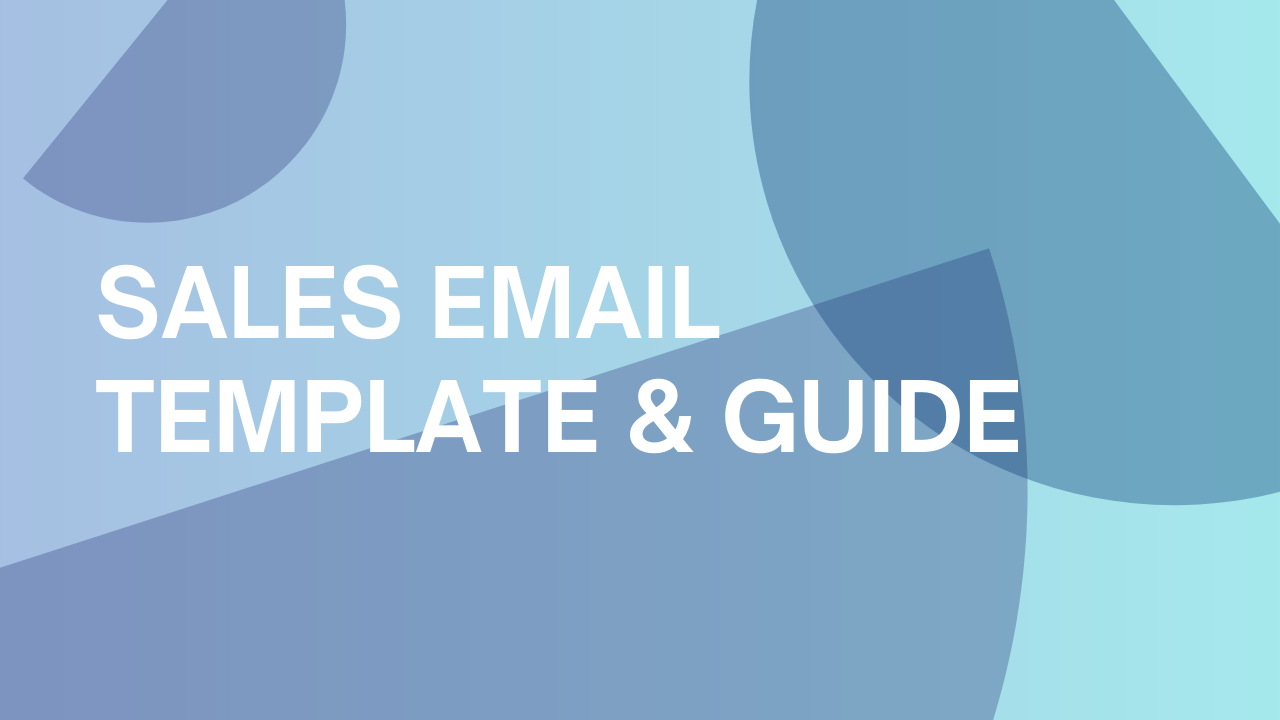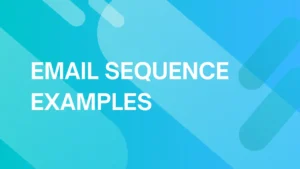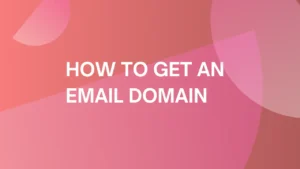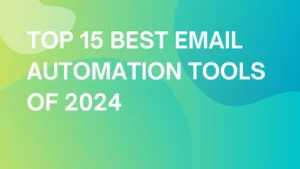
Sales Email Templates: A Simple Guide For Complete Beginners
There’s an art to sales emails that all marketers should master to engage customers and generate leads.
Of course, marketers do everything they can to outperform their previous email, but constructing these emails requires in-depth strategy and research.
So, how do you get started? And what information do you need to win the attention of your audience?
In this helpful guide, we’ll cover the foundations of a sales email, explore the best practices for email marketing and provide sales email templates to advertise your products and services.
Sales emails explained
1. What is a sales email?
A sales email is a form of promotional marketing outreach in which businesses generate customer interest in their products and services.
Sales emails provide opportunities to maintain positive customer relationships and strengthen brand loyalty.
Here are some key reasons why emails should be part of your sales process:
- Generates leads: Email prospecting offers an effective way to interact with new and existing customers to promote your products and services. According to a Litmus report, for every dollar brands invest in email marketing, they make $42 in return. With such a positive ROI, email marketing proves a cost-effective solution for customer engagement.
- Develops your brand voice: Communicating with your audience on a regular basis allows you to establish your brand’s tone and messaging. It familiarizes customers with your company and provides a reliable platform to get creative with your marketing strategies.
- Reaches a wide audience: When compared to other forms of marketing, like social media and SMS messaging, emails are a widely accepted form of business communication. This enables you to expand your reach and interact with new customers to share your brand message. But because email marketing is so vast, it’s crucial to do everything in your power to stand out from the crowd and achieve strong open rates to boost customer engagement.
- Increases brand awareness: Ideally, your emails should engage your target audience, but even when they don’t, your presence in their inbox will keep your brand fresh in their minds. This may inspire users to look up your brand later which could eventually also boost your other marketing KPIs such as your brand popularity, share search on Google, organic traffic on your website, social media mentions, conversions, etc.
2. What makes an effective sales message?
As enticing as it may be to take heavy inspiration from your competitors, effective marketing needs to stand out from the crowd.
Avoid safe, generic messaging and consider new, exciting ways to dangle the carrot in front of your recipients.
To create attractive and appealing promotional emails, make sure to follow these best practices:
- Research your target audience: Make sure you tailor your emails to the right person. To create engaging copy, you must have an in-depth understanding of your reader. Sales emails that target smaller audiences tend to achieve better results. In fact, according to HubSpot Research, 78% of marketers placed subscriber segmentation as the most effective email marketing strategy. Conduct thorough research to understand your target demographic’s unique pain points. This will help to capture their attention and develop interest in your product or service.
- Avoid lengthy messaging: Long emails should be avoided at all costs. Recipients don’t want to expend unnecessary energy reading sales pitches, and you don’t want to deter readers before they reach the call to action. Keep your email copy short and sweet to generate interest and drive them to click the link.
- Consider personalization methods: According to Statista, marketing personalization has become one of the most indispensable marketing strategies among marketers worldwide, with 60% of shoppers agreeing that unpersonalized messaging would cause them to lose their loyalty. Automation solutions can save time, money and energy while achieving excellent results. You can integrate systems that automatically apply individual customer data to assigned templates. For example, “[Prospect name], have you seen our groundbreaking sale?”, or “Turning [Age] never felt so good.” Alternatively, for B2B sales emails, you can target a specific company name. Directly relate to customers to perk up their ears (or eyes).
- Leveraging Email Hooks: Email hooks are key elements that capture attention quickly. They can be a sharp question, a surprising statement, or a compelling offer that draws the recipient in. Integrating hooks effectively boosts engagement and encourages deeper interaction with your email.
- Tap into nostalgia: Although this may not seem relevant to every industry, there are various ways you can incorporate nostalgia into your email marketing. This strategy is one of the best ways to generate an emotional response from your customers, as it triggers fond memories they long to feel again. Since emails support the use of multi-media, your sales team can get creative with how they execute this. Using nostalgia can form positive associations with your brand and demonstrate knowledge of your customers’ interests.
- Offer value to customers: You wouldn’t knock on a stranger’s door to tell them about your day, so don’t do that to a potential customer. Avoid information-heavy content and think about what’s in it for the customer. Do new shoppers get a 10% discount? Do you provide referral benefits? For the best results, make sure there’s value in your messaging so that customers gain something from your interaction. This also helps to build a positive brand image.
3. Is a cold email the same as a sales email?
The short answer is: no.
Cold email marketing involves sending unsolicited emails to your prospective customers or clients to reach out for business opportunities and ultimately generate leads. Whereas sales emails are targeted toward subscribed customers to pitch a product or service.
Cold emailing enables you to increase business visibility to those unaware of your organization for cost-effective brand awareness.
Going cold with your email marketing strategy can prove effective when executed correctly, but cold emailing isn’t always straightforward.
Because cold outreach involves contacting recipients unassociated with your brand, it requires thoughtful action to successfully engage customers.
To get positive results from your cold email campaign, you should:
- Tailor the message to the individual: Don’t speak as though you’re contacting thousands of recipients. Talk to the individual and consider their unique perspectives, interests and needs.
- Validate your brand: When contacting unfamiliar consumers, it’s up to you to prove yourself as an established company that will successfully address their issues.
- Show appreciation: Cold emails ask a favor of their audience. For this, you should express gratitude and even some vulnerability to give unfamiliar recipients a rush of power. Then, let them make the choice to engage with your brand.
What to include in a promotional email
How long should a sales pitch email be?
Pitch emails should be brief — hence the term “elevator pitch”.
You want to be able to pitch your product quickly and effectively. It’s best to aim for 2-3 paragraphs in length.
Any more than that is likely to deter customers from reading your outreach material.
How do you keep a sales email short?
To keep these emails short and sweet, break down the elements of your pitch and cover each point concisely.
You can break down sales emails into three key segments:
1. Awareness – Address the problem
A catchy one-to-two sentence opener that outlines the customers’ common issues.
This might manifest in an anecdote or question to open the conversation.
2. Interest – Build value for your product:
Focus on customer success.
Explain how the product addresses the problem and how the customer benefits from your specific service.
This will function as your action-oriented value proposition.
3. Conversion – Have a strong finisher
A call to action is your final opportunity to convert potential customers with your email.
Make sure you don’t lose your buzz with generic phrasings, such as “Check out our product here” or “Click the link”.
Open-ended questions are fantastic for creating thought opportunities for customers, for example, “How do you see the future of your [related feature of product/service]?”
How to put together a promotional email
Although promotional emails have one key goal — to convert customers — it’s important to understand what kind of promotional email you’re putting together.
There are four main types to choose from:
- Discount offers: To entice customers with value for money.
- Product promotion: To kick-start consumer interest in your product or service.
- Limited-time offers: To generate leads through time-sensitive product promotion.
- Membership emails: To drive customers to buy products through exclusivity.
First, understand the key purpose of your sales email and its place in the sales funnel. Then, start building your content with these pointers in mind:
a) Nail the subject line
To stand out in a busy inbox, a unique email subject line is vital to your success.
Strive to be catchy and conversational, while steering clear of spam detection triggers such as “free” or using ALL CAPS.
Additionally, pay attention to the length of subject lines; data from Invesp shows that open rates are higher when they are 6 to 10 words long. According to Aweber statistics, 36.5% of subject lines are 21 to 40 characters and 34.6% are 41 to 60.
Keep these stats in mind as a rough guideline, but if you have a short, snappy subject idea, it might be beneficial to see how it performs.
b) Personalized subjects and greetings
First impressions are crucial, and saying “Hello” simply won’t cut it.
The way you address customers goes a long way in how you capture and hold their attention.
Personalizing your emails is an excellent way to achieve this.
Utilize customer data to include valuable information, such as name, age, occupation or behavioral activity to catch their eye after a short glance.
c) Make room for data
Find relevant statistics or brief testimonials that reinforce your point and build customers’ trust in your brand.
You can use data from your brand’s research or other studies, but avoid drawing attention to your competitors.
Also, refrain from shoehorning data into your email copy, as it may weaken your argument.
d) Include branded signatures
Let recipients recognize your organization before they start reading.
Brand imagery with stylized, branded signatures makes your company more memorable and gives your sales rep an established, trustworthy appearance.
Make use of two logo colors (maximum) and ensure you only include high-quality images.
For premium signatures, consider adding subtle animations that encompass your brand story.
The motion should be noticeable but not so distracting that customers don’t read your email.
e) Gather your links
Whether you want to paste them into your email or embed them in an interactive format, make sure you have the necessary links that you include in your promotional email.
Avoid using more than one link as it’s best to give the recipient a single direction.
Any further browsing should be conducted by the customer and left to your website to guide their journey.
Email templates
Sales email template
a) Product/service promotion
A sales template should be flexible and easily customizable. Feel free to make adjustments according to your brand’s tone and voice.
| “Hey [Prospect name], Having trouble with [[unique pain point]]? Wishing you could [[outcome of using product/service]]? We’ve got you covered. With [[product/service]], you can [[features of product/service]] with ease. [[Your company name]] strives to empower our [[customers]] with [[industry-specific]] solutions. Ready to [[address the pain point]]? [CTA link]” |
b) Limited-time offer
| “Quick, [Prospect name]! Get up to [[percentage]] off all our [[products]] in our [[name of sale, e.g., Summer, Black Friday]]. Save yourself from [unique pain point] at an extraordinary price! [CTA link] Hurry, offer ends [day].” |
Cold email template
A cold sales email should entice customers with a promise from your brand.
Think of the major, key benefit your product or service has to offer and generate interest through that advantage.
| “{{Prospect name}}, What would you do with an extra 10 hours each week? [[Unique pain point]] wastes valuable time and energy, but for what? Our [[product/service]] saves your schedule by [[feature(s) of product/service]]. Ready to take your life back? [CTA link]” |
| Note: When it comes to cold emails, it can be difficult to contact vast audiences without facing email bounceback. Luckily, you can expand your cold email outreach without risking deliverability. |
Warm up your email first!
Marketers often suffer lackluster results from email marketing campaigns they’ve worked on tirelessly.
But what prevents them from achieving their targets?
Deliverability plays the most vital role in the success of your email campaign. This doesn’t just relate to whether an email was delivered; it’s also about inbox placement.
Customers are highly unlikely to check their spam folder, so if your email ends up in the wrong folder, it probably won’t see the light of day.
The secret to great deliverability is to warm up your emails.
Before hitting send, you should first consider any aspects of your email that might cause issues with delivery, for example, email timing, IP reputation or “spammy” language use.
Warmup Inbox helps you effectively manage your email campaign and optimize its deliverability.
Take a look at our recent case study to find out how we helped SEO toolkit Mangools boost their email performance.
Get set up with Warmup Inbox
To achieve excellent results from your email marketing, sign up for a 7-day demo with Warmup Inbox.
You don’t require a credit card; just sign up with your name and email address, and you’ll get access to our network of 20,000+ continuously changing inboxes.
We’ll also provide useful reports with recommendations to take care of your inbox’s health and interact with your warmup emails to make sure your emails deliver.
Heat up your email campaign with Warmup Inbox today!



